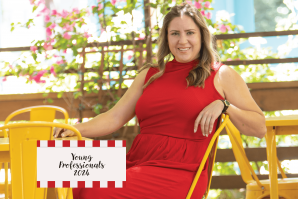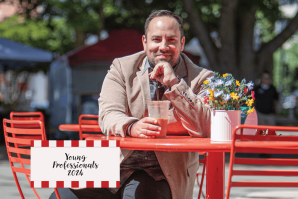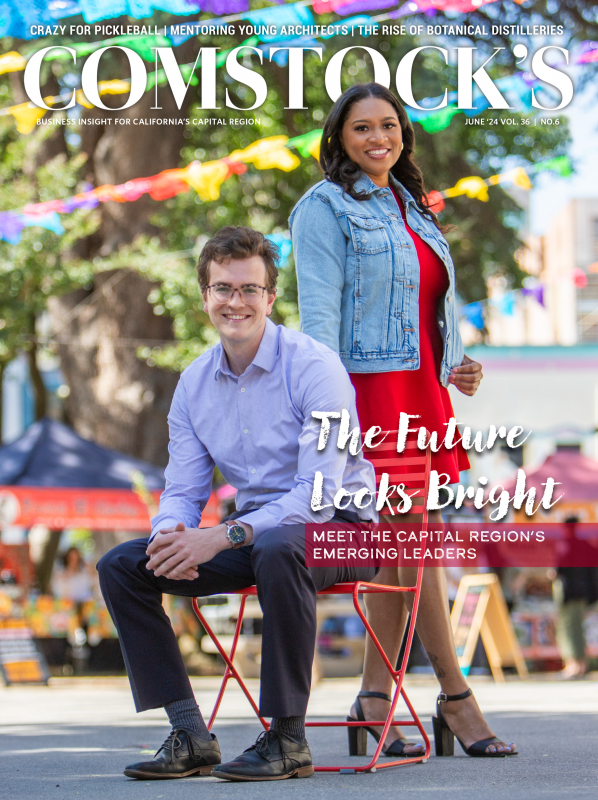In the early 2000s, Brian Whitmore was grinding through his Architectural Registration Exam and California Supplemental Exam one at a time. There were 10 exams in all. “It was nerve-wracking,” he recalls. Whitmore, president and CEO of Sacramento-based Studio W Architects, earned his California architecture license in 2005. During his test-taking tenure, he was required to pass six written exams, three graphic tests and one oral exam for licensure. Prior to 1997, the ARE exams were completed manually with paper and pencil, and the 12-hour design exam was only offered once a year. It was not uncommon for test takers to bring their own drafting tools, a padded chair and some sort of sustenance for the day-long test.
Elizabeth Hawks McBride, a project architect and associate with Nacht & Lewis and the director of emerging professionals for AIA (American Institute of Architects) Central Valley, earned her California architecture license in 2019. The streamlined process consisted of six ARE tests and a multiple-choice California Supplemental Exam. The exams were also offered multiple times a year at several locations, and the CSE was switched from an oral exam to a written test in 2011 to make it more equitable for candidates whose first language is not English.
The field of architecture is changing, and technology is playing a central role, but it’s not the only element that’s shifting: so is the expectation of what young and emerging professionals are looking for in an architectural job. The changes are creating an opportunity for those with different experience levels to engage in a conversation for the good and growth of the profession.
When Hawks McBride was applying for architecture positions, one of her top priorities was flexibility. “I was definitely looking for a firm that appreciated a work-life balance,” she says. “After being in school for six years and putting in some very late nights, that’s not what I wanted for my career. I wanted a realistic pace and support for my growth.” Hawks McBride earned her four-year undergraduate degree in design and two-year master’s degree in architecture from the University of Nebraska-Lincoln. She worked at a small firm in Casper, Wyoming, for two years before moving to Sacramento and Nacht & Lewis in 2015. She was attracted to the firm’s hybrid work schedule, the longevity of the staff and opportunities for her professional growth.
At Nacht & Lewis, Hawks McBride began tracking her Architectural Experience Program, or AXP, hours more consistently in anticipation of taking the ARE, the exams required for licensure. Candidates must amass 3,740 AXP hours that fall into six practice areas under a qualified professional before they are eligible for licensure. The process typically takes three years — on top of the educational requirement — and is governed by the National Council of Architectural Registration Boards. “Sometimes it’s more difficult as a new person if you are not always getting the experience in every area, so it could take longer,” she says.
California is one of the states that also allows candidates to replace the education component with additional years of experience under a qualified professional; in all, eight years of experience or a combination of eight years of education and experience is required. To prepare for the exams, Hawks McBride utilized the in-house study materials at Nacht & Lewis and signed up for the AIA Central Valley study program on Saturday mornings. It took her a little over a year to take and pass the six AREs and the CSE. Nacht & Lewis reimbursed her for the cost of each test she passed.
Hawks McBride is also serving a two-year board seat with AIA Central Valley as the director of emerging professionals. The EP group is very active and recently revived its Mentor Match program, which attempts to match veteran architects with emerging professionals using a speed dating format. At the recent California AIA EP Summit, Hawks McBride had a chance to connect with emerging professional directors from each of the different California state chapters to hear the priorities of their members. “I would say that flexibility in scheduling and working from home was huge,” she says.
Not everyone is convinced that working from home is the right setting for the architecture profession. “At its core, architecture is still an apprenticeship program,” says Whitmore. “It’s sort of a conundrum because the process of being licensed requires an incredible amount of mentorship.” Whitmore believes the key to mentorship is involving junior staff in client and consultant meetings on the job so they truly understand how their work has ramifications to the built environment. He notes the current generation coming out of architecture school are extremely knowledgeable when it comes to the computer technology that’s necessary for a project but lack some of the softer skills that are needed, like how to manage a project, how to design something from scratch or how to create a strong relationship with the client to understand what is needed and then document it. “Those are the skills we’re working on with our younger staff, and that’s more effectively communicated and demonstrated in person.”
Ben Vargas would agree. The young architectural designer with Lionakis in Sacramento comes into the office five days a week, even though the firm offers a hybrid schedule. “I think part of being an architect is that you value the built environment and you learn on the job, so it doesn’t make sense to me to try to do that from home,” he says. After spending two of his final three years of college primarily online, Vargas says he prefers in-person learning and working. He also believes the disconnect between veteran architects and emerging professionals on being in the office is not necessarily a generational one, but rather a cultural one. “I think there are a lot of people who are committed to architecture beyond just the profession or as a way of making money,” he explains. “I think those people tend to be geared towards being in the office and don’t mind putting in more hours than what’s required.”
Elizabeth Hawks McBride, a project architect with Nacht & Lewis,
wanted opportunity for growth and work-life balance in her career
after spending six years in school and putting in late nights to
become an architect.

Vargas says he didn’t really consider pursuing architecture until late in high school when he took a drafting class. A summer program at the University of Texas at Austin followed and introduced him to the more artistic side of the profession. That led to enrolling in the two-year architecture program at Cosumnes River College, then transferring to Cal Poly San Luis Obispo for the final three years. He earned his bachelor of architecture in 2022. While in college, Vargas interned with Lionakis, and the familiarity and trust he built up with the firm were a big draw when looking for a post-grad job. “The biggest thing you can have early on in your career is that level of trust with people, not just to do certain tasks, but also to feel like you are valued and trusted to handle a task that may be a challenge. I would say that’s more important than any kind of specific program or formal training I could get.”
Ginger Thompson, senior associate with Dreyfuss + Blackford Architecture, took a very non-traditional route on her architectural journey. “I didn’t even know what an architect did until I was in my 30s,” she says. “Not because I wasn’t interested, but because it was never introduced to me,” which is why she is so passionate to expose students to the profession at an early age.
Thompson serves as the chair for CREATE, a program offered through the Construction Industry Education Foundation. The collaborative mentorship program introduces high schoolers to architecture, engineering, construction and other trades using a project-based learning competition. The program serves more than 30 high schools in Northern California. “The students have to work together in a group to solve problems, so all those soft skills they need to know, they are learning right out of the gate. The other part I love is that because it’s collaboratively based across disciplines, their foundation of what an architect is — a team player as opposed to a soloist — sets them up for so much more success as they move forward.” The American Institute of Architects also has an educational program with the California Architectural Foundation called Architecture by the Book, where architecture is introduced into local classrooms and communities through book-based lessons. The program was beta-tested by AIA Central Valley and is now available statewide.
Thompson believes her years of experience in an industry outside of architecture — behavioral analysis — makes her a more well-rounded architect. She loved the impact she had in the behavioral analysis field but found it was missing the creative component. After learning about architecture from a colleague, she decided to make a career change. At the time, Thompson was a single mom trying to juggle work and home, so enrolling in a five-year education program wasn’t feasible. Instead, she studied architecture for three years at Cosumnes River College, then went to work for a traffic management company. “They hired me for my CAD (computer-aided design) skills, which was as adjacent as I could get to working for an architecture firm,” she recalls. Next, she took a position with an electrical engineering firm, which gave her more exposure to architects.
While volunteering at a school art function, she met Jason Silva, design principal with Dreyfuss + Blackford. Through that connection, she secured an interview with John Webre, principal and managing partner with D+B at the time. “We had a fantastic conversation, but I distinctly remember John telling me, ‘You don’t bring any experience into this. You are a huge risk, but I am a risk taker, so I am going to take this risk on you.’ I am grateful for the big, intentional choice he made. In taking that risk on me, I felt like I needed to earn my place,” she says. It took Thompson eight years to get the required experience hours, but she passed the ARE and CSE and received her California architecture license in 2022.
Another important role for Thompson is with AIA California, where she serves as vice president of the Academy of Emerging Professionals. Given her background, and her AIA role, she believes she is uniquely positioned to help bridge the gap between veteran architects and emerging professionals. She acknowledges that the line between the two experiences can be stark. “One of the key elements is understanding there is a division and leaving space for that conversation,” she explains, including the dialogue around soft skills, especially in the age of online work.
Despite the number of years required to transition from her former career to architecture, Thompson does not regret it and wants to expose others to the design profession. “My strongest driver is to have a positive effect on the most amount of people, and design is one of those career paths that can affect people over time. The more experiences, stories and backgrounds we have in creating those spaces, the more they will endure and last beyond us,” she says.
Get all the profiles in our Young Professionals issue delivered to your inbox: Subscribe to the Comstock’s newsletter today!
Recommended For You

Young Professionals: Katie Hanten
Meet the emerging leaders who envision a bright future for the Capital Region
In 2021, Katie Hanten founded her full-service design and development firm — Vertical Pacific — through which she’s helping evolve the city’s urban core.

Young Professionals: Jacob Gutierrez-Montoya
Meet the emerging leaders who envision a bright future for the Capital Region
Jacob Gutierrez-Montoya founded Sacramento Contemporary Dance Theatre, whose mission is to translate the work of local nonprofits into art.

Young Professionals: Kevin Dobson
Meet the emerging leaders who envision a bright future for the Capital Region
Kevin Dobson is founder and executive director of Capital College & Career Academy, a public charter high school that trains teenagers to work in construction.

Some Important Bedfellows: Financial Literacy, Art, Reading and Writing
Comstock’s President and Publisher Winnie Comstock-Carlson examines the shortcomings of California’s public school system.

Young Professionals: Jade Rodgers
Meet the 10 young professionals who are rocking it in their careers and community
When it comes to navigating life and work, 916 Ink’s Jade Rodgers is a firm believer in “ubuntu,” an African word meaning “my humanity is tied to yours.” “Our experience in this life is interconnected,” she says.




